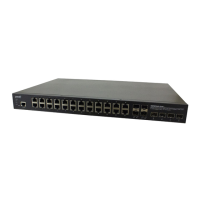Lantronix SISPM1040-xxxx-L3 Web User Guide
33856 Rev. A https://www.lantronix.com/ 483
Example 2: Non-Blocking MRC State Recognized by MRM (Web UI)
This application example shows a Non-blocking MRC state is recognized by the MRM.
Setup: This setup and steps 1-18 in Example 1 above are required.
Procedure:
1. Disable any other Ring technologies and disable Spanning-tree at Configuration > Spanning Tree > CIST Port.
2. Disable 'BLOCKED State Supported'.
3. Configure ring ports to Hybrid mode on the VLAN Configuration page. Assign the VLAN ID as configured in step 4 of
Example 1.
4. Send bi-directional traffic tagged with the VLAN ID set in the previous step.
5. Create a failure on any one of the client ring ports by disconnecting the cable. The client ring ports will be in a
forwarding state instead of blocking. The MRM should reconfigure the path within 200<500ms. The MRM will send test
frames marked with a unique MAC with OUI of 00-15-4E and forwarded by the MRCs to the opposite ring ports per the
interval specified.
6. Verify the MRC reacts to the reconfiguration frames as received by the MRM. The link down on the client ring port
should be detected by the MRC.
7. There should be no traffic loss after path reconfiguration.
Example 3: MRP Roles Set in Web UI
Setup: This setup shows that the MRP can have both Manager and Undefined roles.
Procedure:
1. Disable any other Ring technologies and disable Spanning-tree at Configuration > Spanning Tree > CIST Port.
2. 'BLOCKED State Supported' should be enabled. By default, one ring port will be disabled for loop-free communication.
3. Configure ring ports to Hybrid mode on the VLAN Configuration page. Assign the VLAN ID as set in step 4 of Example 1.
4. Send bi-directional traffic tagged with the VLAN ID set in the previous step.
5. Create a failure on any one of the client ring ports by disconnecting the cable. The MRM should reconfigure the path
within 200<500ms. The Redundancy manager will send test frames marked with a unique MAC with OUI of 00-15-4E
and forwarded by the MRCs to the opposite ring ports per the interval specified.
The disabled ring port should now be enabled and creates a new loop-free topology.
6. There should be no traffic loss after path reconfiguration.
7. On a second client set the 'BLOCKED State Supported' option to disable. The ring port will now be in a forwarding state.
Cause a failure on the ring port of another device that has its blocked state disabled.
8. Verify that frames are forwarded and received by the MRC with blocking enabled. There should be no traffic loss after
path reconfiguration.

